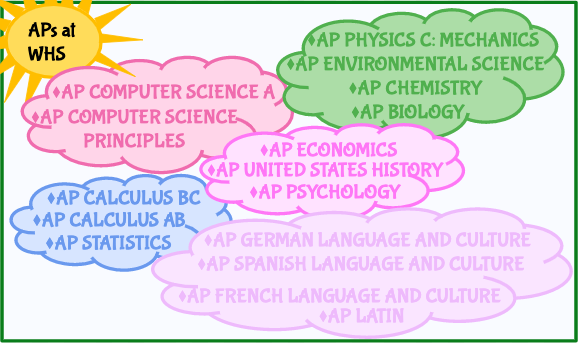For any high schooler, there is immense pressure to take Advanced Placement courses before college. However, for some, this rigor is barely even an option. At a fairly decent sized school of about 1,500 kids like Wellesley High School (WHS), it would be reasonable to think that there would be a wide variety of AP options offered, and to some extent, this is true; we do offer sixteen different APs. But what is not emphasized enough to students, and perhaps more importantly, colleges, is the feasibility of being able to take more than a handful of APs in the span of a Wellesley High School career.
Simply put, an AP class surpasses the difficulty of an honors level high school class. AP courses are regulated by The College Board, which is the same organization that administers the SAT exam. This means that universally, all AP courses have a standardized and regimented curriculum. At the end of the school year, every AP course culminates in a standardized exam similar to an SAT subject test, in that it is only focused on that one topic.
Regardless of how arbitrary practice of standardized testing is, if a high school offers any APs, the most competitive colleges look for their prospective students to have taken them. A college or university will most likely be looking to see if you have taken “the most rigorous courses offered,” which for Wellesley High School means AP classes. However, when high schools don’t offer APs, students aren’t expected to take them. This means that honors classes become the most rigorous course load, and students are not pressured to overextend themselves by taking APs.
It is important to keep in mind that taking an AP class does not automatically lead to success. As Stanford’s education expert Denise Pope says, “if you’re pushed into [an AP course] without good preparation and without a safety net in place at the school to help you if you get in over your head, then it may be more harmful than helpful.” Therefore a solution to the stresses caused by the pressure to take APs would be to not offer them at all.
Since we do have APs at the high school, the biggest problem at the moment is not getting rid of them, but rather, conveying to colleges the inability to take more than a few APs within the constraints of our time at WHS. The high school offers sixteen different APs which, on paper, sounds like a broad selection. However, there are so many prerequisites and scheduling conflicts, that in reality, on average the most any one student takes is around four. Once the logistics of taking multiple APs are examined, the pool of potential AP credits drops quickly from sixteen.
For instance, until Junior year, the only APs underclassmen who are on a regular, non-accelerated track (meaning they are taking course levels matching their grade and did not place into a higher level of math when they were in Wellesley Middle School) can take are AP Computer Science Principles and AP Computer Science A, meaning that the rest of the fourteen APs can only be taken junior and senior years. In foreign language, if a student continues the same language from middle school their freshman year of high school, they are eligible to take an AP language. However, if you start a new language freshman year, the possibility of taking an AP language is immediately suspended, barring any outside tutoring. WHS offers AP Spanish, French, German, and Latin. Even taking the liberty of assuming a student continues the same language from middle school, that takes away three other course options from the list of available APs.
Next, looking at the science options, there are four different APs offered: AP Biology, AP Chemistry, AP Environmental Science, and AP Physics C: Mechanics. Out of these, the only two AP sciences students are permitted to take their Junior year are AP Chemistry and AP Environmental Science, and if you decide to take environmental science your Junior year, you must simultaneously take biology. Limited by space in the schedule, the greatest amount of AP sciences a student could take in high school would be two. It would only be possible to take more than two if a student decides not to take one of the core classes either junior or senior year.
For AP math classes, there is either AB or BC AP Calculus or AP Statistics. The main variation between AB and BC Calculus is their level of difficulty, so it is unlikely that one student would take both. All of these can only be taken senior year, so at the most, you can only have two AP math courses in high school, other than the aforementioned computer science APs.
Likely the most shocking absence of APs at WHS is in the humanities. AP United States History is the only history offered, AP Psychology and AP Economics are the only “social sciences” offered, and there are currently no English APs at all. The reasoning the guidance department gives for this lack of English AP offerings is that junior and senior honors English courses are just as challenging as the curriculum of the AP Englishes. However, this is true with departments other than English alone, so if this reasoning is applied to honors classes in the English department, then why don’t other equally as rigorous science courses go by the same logic and discontinue their APs?
Furthermore, it is important to remember that there are only seven blocks open to take classes each year. Even on top of the limited selection, perhaps the most restrictive aspect of taking APs is the scheduling. Some of the AP classes only meet one, or maybe two, color blocks. Especially if already taking other classes that only meet one color block, this timing limits the scheduling greatly.
The problem with the AP offerings as they are now is how misleading the number of offerings appears. Colleges assume that if students don’t take AP classes, they aren’t taking courses of the highest rigor. However, at WHS, it can be seen in the English department in particular that our honors classes are often just as challenging as the AP curriculum demand. If this is the case for the English department, then why do we offer APs for other departments at all? For what is essentially just a more exclusive label to a class level, the stress isn’t worth it. Besides removing APs from being offered at WHS altogether, there is not much to do to convey the limitations in scheduling to potential colleges.
Fortunately, a helpful step in helping higher learning establishments understand the constraints around APs is already in motion: this year, the Guidance department edited the school profile, a document which is sent to college in the application process detailing the specifics of a high school, so that it is much clearer in conveying the limitations of scheduling, and in particular the limitations for AP courses. Although this fix is no match for discontinuing APs at WHS altogether, hopefully, by changing the school profile to be more comprehensive and intelligibly understood for colleges, there will be less stress put on students to feel like they aren’t meeting college requirements by not being able to take APs.

